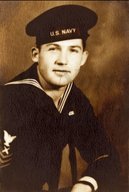
|

|
|
|
|
James was born in Kilgore, Texas, and grew up on a 205-acre farm near Overton. He was the oldest of six children of James H. Clark and his second wife, Anna Adams Clark. By his first wife the elder Clark had two boys and two girls. The family raised cotton, corn, peanuts, and peas, as well as a garden for their kitchen table. "We had lots of sweet potatoes and fresh English peas," he recalls of their daily fare. For meat they kept hogs, cows, and chickens. Along with other farm work James was plowing, usually with mules, "at an early age". After picking cotton in September, his father would load "about twelve hundred pounds" in a wagon with sideboards and take it to the gin to separate seed from cotton. "A bale of cotton would weigh around five hundred pounds from that twelve hundred pounds of seed and cotton," he says. Their home had no electricity. A fireplace, kerosene lamps, and lanterns provided light, while a wood stove kept the kitchen warm. To cool milk they lowered it into the well or spring in metal gallon buckets. On Saturdays they went into Overton to buy groceries, mainly sugar, coffee, and flour. James attended Red Level School, taking with him his lunch, "a biscuit with a hard-fried egg in the middle of it, wrapped in newspaper," he recalls. Around 1927, the Clarks moved to California, where they lived on a farm near Clovis that grew apricots and grapes. They went on to Fresno where his father worked for the city. James held a newspaper route, delivering newspapers before going to school each day, and making twenty-two dollars a month. The Clarks returned to Texas in the early 1930s, lived briefly in Marshall and Tatum, then settled on a farm in Beckville, where his father sharecropped. James graduated from Beckville High School in 1935, worked in construction for two years, and then joined the U.S. Navy in March of 1937. "I'd never seen a ship," he says. After boot camp in San Diego, he was assigned to the USS Utah (BB-31) as a gunner's mate on this gunnery training ship. With the Utah docked in Pearl Harbor, James was serving as an instructor in a shore school, teaching sailors the 50-caliber machine gun, in the fall of 1941. He was transferred back onto the ship on December 4, 1941. On the morning of December 7, James looked out a porthole to check the weather. "I saw smoke from the air station," he says. "So I looked up in the sky and I saw two Japanese planes. One was bombing the air station and I don't know where the other one was going." At that moment a torpedo slammed into the port side of the ship. James stayed aboard the sinking ship to help Lieutenant P.H. Hauck close watertight doors and lower compartments, an action for which he would later earn a citation. He made it to the top deck but had to swim underwater past a ship's overhang to reach open water. "When I came out, I was in the clear," he says. The Utah, he says, lost 64 men out of a complement of 365. A rescue boat picked up James and put him ashore, where he saw a two-man Japanese submarine enter the harbor and fire a torpedo that missed its target. A destroyer dropped depth charges and, James believes, destroyed the submarine. Meanwhile, he says, "I'm covered up with oil and my eyes are burning." He was treated in a dispensary, then helped clean the Cosmoline coatings from 30-millimeter machine guns and assemble them for defense. James was soon transferred into a salvage crew to clean up Pearl Harbor, and then in the spring of 1942 was sent to the Naval Proving Ground in Dahlgren, Virginia, to teach in a school for anti-aircraft gunners, led by the captain of the Utah. James was requested because he was a gunner's mate on the ship. In March of 1943, he married Ellen Dunn, a woman from Ohio working at the Pentagon. (They would have five children, twelve grandchildren, and seven great-grandchildren.) After two years with the school, James was assigned to the USS Winston (AKA-94), an amphibious force ship. At Pearl Harbor it loaded up with soldiers, tanks, trucks, guns, and ammunition. Once at sea, James saw he was in the middle of a vast armada. On that voyage the ship heard the news about the bombings of Hiroshima and Nagasaki. Before the Winston could reach its destination with its soldiers and equipment, Japan surrendered. In the coming months the Winston sailed twice between San Francisco and Japan. On December 1, 1945, the Winston was assigned to Norfolk. James made a career of the navy, remaining on active duty until his discharge in 1956 in Newport, Rhode Island, as chief gunner's mate. He lived in Texas for about a year and a half, then returned to Norfolk to work 20 years for the city, mainly with the health department. Ellen passed away in 1993. James returned to Texas and married Lorene Wyatt Crump in October of 2000. James sums up his war experience this way: "I was at Pearl Harbor when the war started and I was at Pearl Harbor when it ended." |


